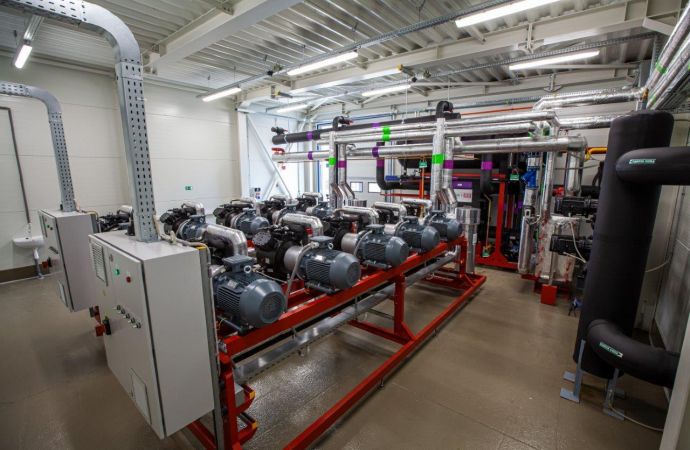ABC Food Machinery replaced Milsy’s aging R134a system and cut 40% in electricity use.

Inside the Milsy ammonia machine room.
By changing Slovak dairy processor Milsy’s decade old R134a indirect cooling system to ammonia/NH3 (R717), ABC Food Machinery enabled it to realize electricity savings of 40% over six months.
In 2020, Milsy, based in Bratislava, Slovakia. approached ABC Food, also based there, to replace its cooling system. By August 2020, a brand-new 800kW (227.5TR) ammonia installation was complete, producing cold water for milk production.
“After six months of operation, we can say that our machine has achieved a 40% lower energy consumption as compared to the previously installed 710kW (202TR) indirect cooling system charged with R134a,” said Juraj Švingál, Technical Sales Director for ABC Food.
This results in a large saving in emissions – both directly from the refrigerant and indirectly from the energy saved. The system also generates 150kW (43TR) of waste heat, which is used for domestic hot water and heating, also saving on steam production.
Milsy was searching for a new, reliable, economic and environmentally friendly system that didn’t include refrigerants that could be restricted in future. ABC Food did the calculations for the operating savings in electricity and found a good opportunity for savings with an ammonia replacement system, explained Švingál.
The new refrigeration system comprises a flooded gravitation plated heat exchanger chiller, complete with cascade piston compressors from HKT Goeldner, a desuperheater, and condensers with adiabatic spray. The system offers precise regulation of the cooling power in a flexible manner, able to change quickly without freezing the plate heat exchanger; this is despite the water in the plate heat exchanger being cooled to near the freezing point (0°C/32°F) at times.
Because the project is situated very near public housing, noise from the refrigerant plant had to be kept to a minimum. Another challenge was the fact that the demand for cooling changes drastically from 80 to 800kW (22 to 227.5TR) in a 24-hour cycle, and the system has to accommodate this. The cooling demand spikes when the milk first comes in and needs to be cooled, as well as after pasteurization. For the rest of the time, the cooling demand is much lower at around 10%.
“Although the client is happy with the system, we are constantly improving our training and skills to make the system better and get more precise settings for better efficiency,” said Švingál.
Related stories



